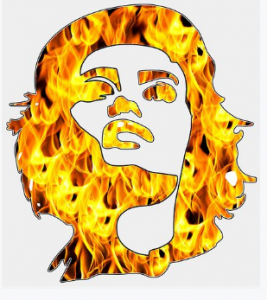Contents
Heat And Your Hair

Have you ever wondered about the heat you use on your hair? Whether it is natural (the sun), thermal (electrical) or personal (body)? And its effects on your hair? This article will be looking at most of the aspects associated with heat and its affect on hair – YOURS!
Let’s start with:
NATURAL HEAT – the Sun
We all love the luxurious heat generated by the sun, especially on a cold winter’s day! However, do we prepare our hair and skin to absorb the effects of Mother Nature and her love? We need to be aware of the environmental effects on our tresses.
Sunlight is really the electromagnet radiation given off by the sun. It is an infrared, visible and ultraviolet light. This light is filtered through the earth’s atmosphere and is called daylight once the sun is seen above the horizon.
When the sun’s light is not blocked by cloud cover, it is called sunshine which is a combination of bright light and radiant heat. When it is blocked by the clouds, it is experienced as diffused light – meaning, contrary to what most people don’t realize, the sun is still ‘working behind the scenes’ even though there is cloud cover!
The ultraviolet radiation of the sun is both good and bad. It is a primary source of Vitamin D3 and also considered a mutagen ( ‘mutagen is a physical or chemical agent that changes the genetic material, usually DNA, of an organism and thus increases the frequency of mutations above the natural background level'[1]); sometimes which can cause cancer.
Yes, there are times when we add some sunscreen to our faces, arms, and legs – oh yes, and on our entire body when we are pointedly working on that A1 tan, but we often forget our crowning glory!
Our hair needs heat protection from the sun as well. The sun’s rays can and do emit real voltage which can burn and sometimes even scar our skin from too much contact.
How can we protect our hair from the sun’s rays?
There are ways to protect or off-set the effects of the sun on our tresses. The more common ways are:
- wear a hat or scarf while you are outside, especially during the hours when the sun is at its highest exposure, i.e. 10am-2pm
- if no hat (not a hat person like myself), apply a surface protectant like coconut oil
- apply hair conditioner, especially while/before swimming
- time your sun exposure
Thermal heat and your hair – what is thermal heat?
Thermal heat can be defined as the effect caused by the movement of molecules and atoms within matter which in turn produces energy. Quite simply stated: it is how energy such as heat is produced.
You can use thermal heat from several heat-producing implements like:
- blow dryers (ion, ceramic types)
- hair dryers – hooded hair dryers (hard-hat) or plastic cap hair dryers
- hot irons – electric (thermal-heated),direct heat (fire), curling, flat
- hot rollers – electrical, microwavable, magnetic
- heating-caps – thermal(electrical)
Naturally, the less you use heat from the above sources, the better it is to optimize the health of your hair. I am not saying by no means that one needs to totally obliterate these objects, surely not!
However, I do recommend a minimalistic approach to be taken while using any of these heat-producing hair tools.
Can the hair be protected from thermal heat?

There are products out there on the beauty market which claim to protect our strands from heat-damage. But do they work? Is it mind over matter? Does it really protect the hair?
Quite honestly, I have found that one has to experiment with various products to find that happy medium – to find out if it helps or hinders your hair health. I will provide a short list here, though I have not tried them all.
I have tried the first two and I found that they left a thin coating on my hair. Did it help while I used thermal heat on my hair? Well, I would choose to believe that it did, in the sense that it minimized the amount of heat exposure while I used the heat implement of choice. Now, that was a long time ago, as today, I rarely, if ever, use any direct heat on my hair. The best type of heat for your hair is indirect heat.
Common heat protectants:
Good ‘ole Body Heat
Now, the best way to use heat on your hair is simply using what your body gives you! Yes, our body is a great functioning machine which more likely than not, provides us with all the things we need for great health.
With minimal products, we can get our bodies to help our hair journey. To produce heat for our hair health, we can use:
- a plain ‘ole plastic bag, plastic cap
- a foil made reflective type plastic cap
We can use these ‘caps’ whenever we want to give our hair a deep conditioning treatment. Simply donning one of these caps and wearing them for about 15minutes or even overnight, will surely give some heat to make your hair product work.
The main advantage of using our body heat is simply capitalizing on the healthy heat that anyone can use at anytime for our bodies.
I hope this article was indeed an eye-opener for you. Please leave any feedback in the comment section below and thanks for stopping by!

REFERENCES:
- Wikipedia – https://en.wikipedia.org/wiki/Mutagen

Hi Michelle,
This was indeed an eye opener and a very interesting read. I never knew the potential threats of vitamin D3. I still have hair which is good but going greyer rapidly, which is not so good lol.
Best regards
Sean
Hello there Sean,
Thanks for stopping by. You made me smile about the graying part…LOL. Yes, I guess it’s a symbol of maturity and experience, so enjoy it. BUT, if you like, you could always use a natural way to make it easier on the eyes – go check out my article on Henna and Indigo as natural plant hair color agents, it might interest you…and your hair. LOL
In any event, take care of you health, including your hair!
Michelle